The Role of Round Living Room End Tables in Design

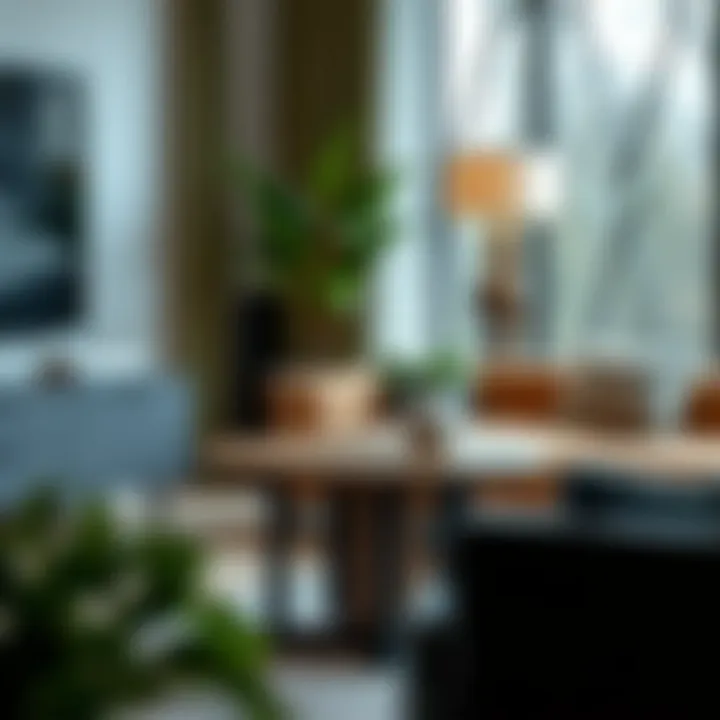
Intro
Round living room end tables serve multiple purposes in contemporary design, acting as both functional pieces and eye-catching decor. These tables, often found next to sofas or armchairs, provide a surface for placing beverages, books, or decorative items, while also contributing to the overall aesthetic of a room. Choosing the right end table boils down to understanding your space, your style, and the materials that complement your existing decor. This guide will navigate you through the key aspects of selecting and styling round end tables, ensuring a harmonious fit in your living spaces.
Furniture Design Trends
Trending Materials and Textures
In recent years, the materials for furniture have diversified significantly. Homeowners and designers alike are leaning towards sustainability, with options such as reclaimed wood and bamboo gaining popularity. Not only do these materials offer durability, but they also add character to your living area.
Glass, used for tabletops, provides a sleek appearance, promoting an airy feel. Meanwhile, metals like brass and steel can underscore a modern design, reflecting light and enhancing visual interest in an otherwise simplistic design.
Textures, too, play a crucial role in shaping the atmosphere of a space. Think about pairing a smooth glass surface with a textured fabric sofa or using a rustic wooden table alongside sleek leather chairs. This contrast can create depth and intrigue.
Color Palettes and Styles
Round end tables come in a myriad of colors, significantly impacting a room's feel. Neutral tones, like beige and white, remain perennial favorites, allowing for easy coordination with various decor styles. On the bolder side, rich jewel tones such as emerald green or sapphire blue can act as centerpiece elements, drawing the eye and sparking conversations.
Mixing styles is an exciting trend as well. You might find a vintage round table juxtaposed with modern furniture, creating a unique blend that showcases personal taste. For a more cohesive look, ensure the table's color harmonizes with the overall theme of the living room, whether it’s modern, traditional, or eclectic.
"A well-chosen end table functions as an anchor in a living room, uniting various elements of decor while offering practicality."
Practical Tips for Furniture Selection
Assessing Space and Functionality
Before selecting a round end table, assessing the available space is vital. Consider the layout of your living room; the table should complement, not clutter. Calculate the approximate dimensions and allow for sufficient space to walk around comfortably. A good rule of thumb is to ensure there’s about 18 inches between the sofa and the table to facilitate ease of movement.
Furthermore, think about how you’ll use the table. If it’s a high-traffic area, sturdy materials are essential. For conversational spaces, you might prioritize height and size to encourage engagement among guests.
Balancing Aesthetics with Comfort
The balance between aesthetic appeal and comfort can be a tightrope to walk. As you choose a round end table, consider how it fits into your lifestyle. Family settings may require more robust pieces that can withstand everyday usage, while more formal spaces might be better suited for delicate, elegant designs.
Style can often dictate comfort too. Soft edges on tables can help create a relaxed atmosphere, ideal for social gatherings. It’s worth exploring various styles to find something that not only looks good but also feels right for your home.
For additional insights and resources on home design, be sure to explore:
By reflecting on these trends and practical tips, homeowners and designers alike can make informed decisions when selecting round living room end tables, resulting in spaces that are both functional and aesthetically pleasing.
Understanding Round Living Room End Tables
In the realm of interior design, round living room end tables hold a unique and vital position. These versatile pieces serve not just as functional furniture, but also contribute significantly to the overall aesthetic and flow of a space. Understanding their various aspects, from definition to significance, can empower homeowners and designers, ensuring that their choices align with both utility and style.
Defining Round End Tables
Round end tables, as the name implies, are furniture pieces characterized by their circular tops and often short stands. These tables may range in size from compact to more substantial ones, designed to complement the seating arrangements typically found in living rooms. While their straightforward design seems simple at first glance, the variety of finishes, heights, and styles available can make them complex choices ranging from casual to formal aesthetics.
Round end tables can vary greatly; some might have intricate carvings or metallic accents, while others boast minimalist designs that blend seamlessly into modern decor. Their circular shape offers a softness that sharp cornered tables often lack, which contributes to a more approachable and inviting atmosphere.
Significance in Interior Design
The importance of round end tables in interior design is twofold: they are both practical and stylish. From a practical perspective, these tables are essential for functionality. They provide a surface for drinks, books, lamps, and personal items, making them indispensable for comfort and convenience in living spaces. Because they tend to take up less visual space than rectangular options, they can be ideal for smaller rooms, ensuring that there’s still enough flow in the area, even with limited square footage.
From a stylistic standpoint, round end tables can enhance the overall decor by bridging gaps between various elements of a room. They can soften the lines of rigid furniture arrangements, creating a more harmonious layout. Their ability to fit in corners or be placed easily beside chairs makes them flexible pieces, adaptable to different room configurations and decor themes.
Round end tables not only serve a function, they also harmonize the aesthetics of your living space, making them a must-have for any well-arranged room.
In short, round end tables encapsulate an essential balance of utility and beauty, making them a key element in creating an inviting living environment. Their definition and significance illuminate the many possibilities they bring to both homeowners and interior designers alike.
Functional Benefits of Round End Tables
Round end tables play a crucial role in enhancing any living room by providing both practical and aesthetic advantages. They are more than mere decorative elements; they serve specific functionalities that can transform the usability of a space. In this section, we’ll delve into the unique features of round end tables, emphasizing their benefits concerning space optimization and accessibility.
Space Optimization
When one thinks about furniture, especially in a living room, maximizing space is often top of mind. Round end tables excel in creating an illusion of openness, particularly in smaller rooms, where square corners of traditional tables can make the area feel cramped. The absence of sharp edges makes these tables particularly inviting, encouraging flow around the space.
- Ease of Movement: With a round design, there are no protruding corners to navigate around, minimizing the risk of accidental bumps and bruises. This is especially beneficial in high-traffic areas.
- Flexible Arrangements: The circular shape allows for various configurations, whether placed alongside a sofa, between armchairs, or even as a standalone accent piece. This flexibility means you can experiment with layouts without worrying much about fitting into a specific arrangement.
- Versatile Size Options: Round end tables come in various sizes, making it easier to find the perfect fit for your space. A smaller, coffee-table-like table can nestle into a corner, while a larger one can be a statement piece creating a focal point in the room.
"Round tables create spaces that feel more welcoming and less confined, making it easy to invite conversation and relaxation."
Accessibility and Convenience
Accessibility is another cornerstone benefit of round end tables. They offer practical usage conducive to the comfort of your gathering spots. Citing their user-friendliness:
- Unobstructed Surface: These tables provide a continuous surface for placing drinks, books, or decorative items. Unlike their rectangular counterparts, there are no hidden angles where an item might be out of reach. That makes it simple for guests to grab what they need without having to stretch awkwardly.
- Social Engagement: The round shape facilitates conversations as everyone can see and talk to each other without any barriers. Whether it’s during a lively game night or a casual gathering, these tables foster an inviting and connected environment.
- Child-Friendly: For homes with toddlers or young kids, round edge tables minimize the risk of injury, making them an excellent choice for family spaces. They can be positioned where children are active without the constant worry of sharp corners causing accidents.
By marrying supreme functionality with style, round end tables stand out as essential components in contemporary living rooms. Their ability to blend utility with elegance allows homeowners and designers to create spaces that reflect individual personality while serving their practical needs.
Design Styles Compatible with Round End Tables
Round end tables are not just functional pieces of furniture; they can become pivotal elements that draw a room together. Understanding the design styles compatible with these tables allows homeowners and designers to create cohesive, inviting spaces. Many factors can influence the choice of style, including the desired ambiance, existing furniture, and personal taste. Here, we will delve into three significant design styles that harmoniously incorporate round end tables: modern aesthetics, traditional designs, and eclectic approaches.

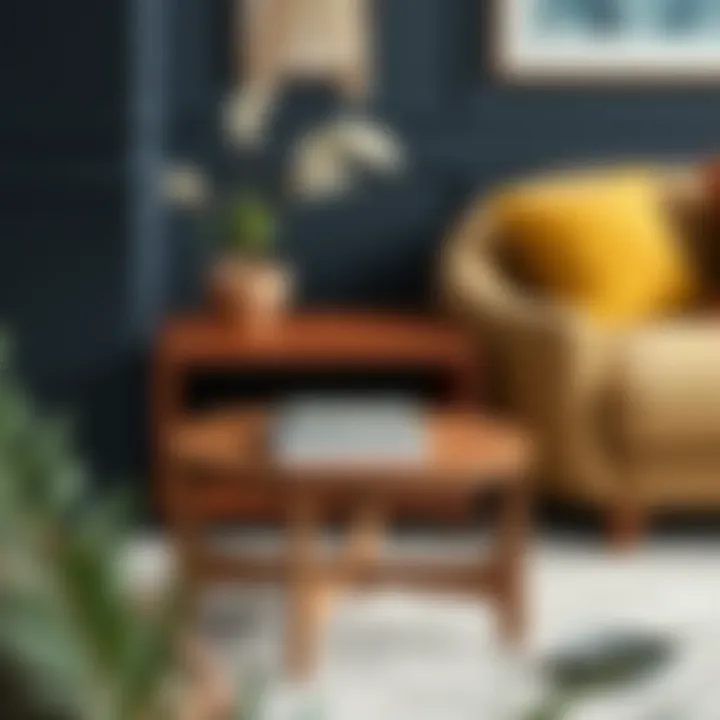
Modern Aesthetics
When talking about modern design, think sleek lines, minimalism, and an emphasis on function. Round end tables that fit within this aesthetic tend to favor simple silhouettes with clean edges. They can be made of materials like metal or glass that align with the contemporary vibe.
- Function Meets Form: One of the essential aspects of modern aesthetics is that the furniture does not clutter a space. Round tables with a glass top and a metal base, for example, offer beauty without blocking the visual flow of the room.
- Color Palette: Colors in modern design often lean towards neutral or monochromatic schemes. A round end table in a bold color can, however, act as a statement piece, adding just the right pop to the decor without overwhelming it.
These tables perform more than just a duty; they elevate the visual appeal of the room while keeping everything looking spacious and airy.
Traditional Designs
Traditional design, on the other hand, is all about warmth, coziness, and a rich aesthetic. Round end tables in this style usually incorporate organic materials like solid wood, showcasing intricate carvings or rich finishes.
- Timeless Appeal: The classic look of a round mahogany end table, for instance, brings a sense of permanence and sophistication to any living room. Such tables often serve as focal points, adorned with decorative items or family heirlooms, bridging personal history with design.
- Layering Textures: In traditional spaces, it’s not just about the table itself. Layering contrasting textures, like pairing a smooth wooden table with a plush fabric or a knotted rug, enhances the tactile experience of the room.
The warmth traditions bring implies that comfort can be just as stylish as modernity can be sleek.
Eclectic Approaches
For those who enjoy a medley of styles, eclectic design represents the freedom to mix and match. Round end tables in this category can vary widely, often using unexpected color combinations and materials that might not traditionally go together.
- Be Bold: An eclectic end table might incorporate vintage elements with whimsical colors. For instance, a distressed painted table sitting next to a plush mid-century modern armchair can create an unexpected yet delightful juxtaposition.
- Curate Your Collection: These spaces allow for curated collections or personal items to shine. An end table can act as a platform for showcasing interesting decor, like a unique vase or a stack of eclectic books, providing both functionality and personality to the setup.
In an eclectic space, there are no hard rules, reflecting a homeowner's identity and journey through different styles.
Each design style brings a different flavor to round end tables, turning a simple piece of furniture into a characterful statement that resonates with the overall theme of the living space.
Materials Used in Round End Tables
The materials used in round living room end tables are not just about aesthetics; they significantly influence functionality, durability, and even the ambiance of a room. When homeowners and designers consider end tables, the choice of material can transform a simple piece of furniture into a captivating centerpiece that enhances the overall design of the living space. Different materials come with their own distinct characteristics, benefits, and maintenance needs, and understanding these can guide one to make better selections suited to their personal style and functional requirements.
Wood Varieties
When talking about round end tables, wood is often the go-to choice for many. The rich textures and natural grains provide warmth and character, fitting effortlessly into various decor styles. Common types of wood used include oak, maple, walnut, and cherry, each bringing its own unique aesthetic and strength.
- Oak is known for its durability, making it a favorite in homes with high foot traffic. Its natural finish allows for easy blending with various color schemes.
- Maple provides a lighter appearance, ideal for modern minimalist styles. Its fine grain takes stains well, offering many options for color schemes.
- Walnut, with its deep hues and striking patterns, exudes luxury and richness. Its hardwood nature means it lasts long, complementing both traditional and contemporary interiors.
- Cherry darkens over time and adds an organic touch that can soften modern looks and amplify classic themes.
When choosing wood, consider the finish as well. Some prefer a natural look, while others may opt for painted or lacquered finishes to match surrounding decor.
Metal Options
Metal end tables represent a shift towards the industrial vibe that's become popular in recent years. They add sleekness and a hint of modernity to any space. Common metals used include steel, aluminum, and iron, each offering unique visuals and benefits.
- Steel is commonly used for its strength and ability to withstand scratches and denting. It’s perfect for homes with children or pets as maintenance is straightforward.
- Aluminum is lightweight, meaning it can easily be moved from room to room, even when loaded with items.
- Iron offers a robust appeal, often found in vintage or ornate designs. It can be a conversation starter with its dramatic look.
Metal finishes can range from polished to matte, or even rusted for a more rustic ambiance. Understanding where and how metal tables will be used can help identify the right finish, enhancing either modern or eclectic interior styles.
Glass and Acrylic
Glass and acrylic tables introduce a sense of openness in a room. These materials are particularly valuable for smaller spaces, as their transparency can make an area feel less crowded.
- Glass is classic and can be clear, frosted, or tinted. Its reflective properties can play with light beautifully, adding a dynamic element to the room. However, it requires careful upkeep to avoid fingerprints and smudges.
- Acrylic, on the other hand, is nearly unbreakable and exceptionally lightweight, offering a modern touch. It provides a chic aesthetic without the fragility associated with glass. Acrylic tables are also easy to clean, making them a popular choice in families with kids.
Choosing between glass and acrylic often depends on personal preference for durability versus traditional aesthetics. Both materials can cleverly enhance decor while offering practicality in usage.
Understanding the materials used in round end tables allows homeowners and designers to make informed choices that not only elevate the decor but also provide lasting utility. The right material can create harmony between durability and style, making your living space a joy to experience.
Color Schemes and Finishes
The color scheme and finish of round living room end tables can drastically influence the ambiance of a space. These elements are not merely decorative; they play a crucial role in how the table interacts with its surroundings and can enhance or detract from the overall aesthetic appeal. When selecting a round end table, it’s essential to consider how the colors and finishes will complement the existing decor and create a cohesive look. In the world of interior design, colors evoke emotions and responses; they can make a space feel warm or cool, spacious or cramped, sophisticated or casual. Thus, getting the color and finish right is a crucial aspect of styling a living room.
Natural Finishes
Natural finishes, such as wood stains that showcase the grain and texture of the material, offer a timeless elegance. They bring warmth to a living space and can adapt to a variety of styles, from rustic to contemporary. When opting for a natural finish, it’s wise to consider the type of wood used. For instance, oak has a pronounced grain that can add depth, while maple tends to have a softer appearance. A table finished in walnut can introduce a rich, dark tone that creates a striking contrast against lighter furniture.
The beauty of natural finishes is their ability to age gracefully. Over time, they develop a patina that tells a story, adding character to the piece. However, it’s important to keep in mind that maintenance can vary. A minimalistic approach, with just a bit of oil to nourish the wood, can often suffice.
Bold Colors
Diving into bold colors can transform a round end table into a centerpiece rather than a mere accessory. Bright hues like cobalt blue or vibrant yellow can energize a space and make a statement. This approach often works well in eclectic designs or modern interiors that embrace a playful spirit. However, when adopting bold colors, balance is key. Too many striking colors in one room can create chaos, so using a bold table as an accent against neutral surroundings often yields the best results.
Another aspect to consider is the psychological impact of color. For example, red can stimulate conversation and activity, making it great for social spaces, while calming tones like teal promote relaxation. Therefore, when choosing a bold color, think about what you want the space to communicate.
Textured Surfaces
Textural variation can significantly enhance the quality of an end table. Surfaces that incorporate texture grab attention and invite tactile engagement. Whether it’s a hammered metal finish, a carved wooden pattern, or a glossy lacquer, texture adds depth and interest. Textured surfaces can serve as a striking contrast to smoother elements in the room, helping to break visual monotony.
Consider the overall design language of the space. For a bohemian style, consider tables with woven rattan or interesting ceramic finishes, as these materials can emphasize organic shapes and layers. On the other hand, industrial designs lend themselves well to raw, rugged textures like concrete or unfinished wood, which can echo the loft-style living spaces.
Incorporating textured round end tables can create dynamic areas that encourage interaction, adding visual intrigue and complementing the tailored aesthetics of many modern homes.
Choosing the Right Size
When it comes to round living room end tables, size is not merely a trivial detail; it’s a fundamental aspect that can either make or break the functionality and visual harmony of your living space. Choosing the right size for these tables means considering the proportions relative to the surrounding furniture and the overall dimensions of your area. A proper fit not only emphasizes the aesthetics but also enhances convenience and accessibility in everyday use.
Proportions in Living Spaces
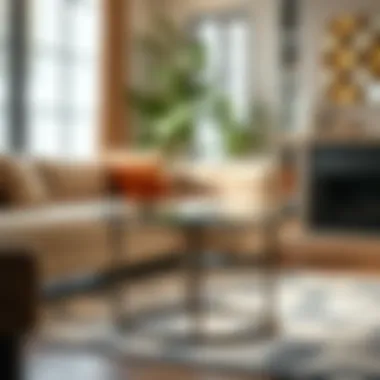
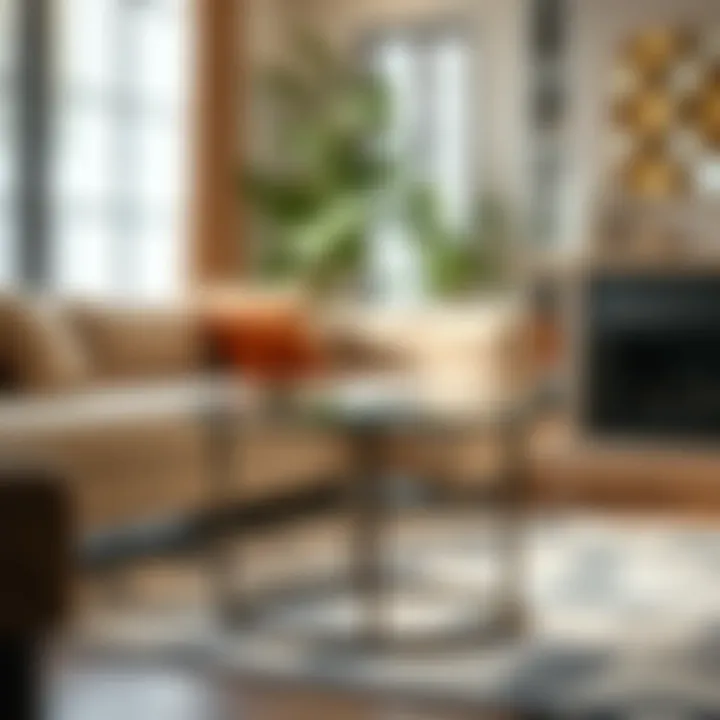
The proportions in living spaces determine how each piece of furniture interacts with the rest of the room. A table that is either too large or too small can throw off the whole balance of the environment. When selecting a round end table, aim for a size that complements your sofa, chairs, and other furnishings without overcrowding or leaving awkward gaps.
- Visual Balance: A table that sits at the same height as the arm of your sofa creates a seamless flow. Most round end tables are generally between 20 to 24 inches in height. This range works well with standard seating.
- Negative Space: Ensure there is enough space around the table. Ideally, allow about 18 inches between the table and seating options. This makes moving around easy and maintains an open feel to the room.
- Focal Point: If you're using a large or statement piece, such as a bold lamp or a vibrant floral arrangement, consider a smaller table to play down the theme. This way, the end table supports without overshadowing the main elements.
Scaling with Existing Furniture
“Scaling with existing furniture” is where personal style and practicality meet. You want your round end table to fit within the context of your room's style and size. Consider existing pieces and their visual weight.
- Match the Volume: A large sectional sofa pairs well with a larger round end table. If you’ve got a petite love seat, a small table would maintain proportion. This balance enhances the overall aesthetic.
- Layering Heights: Think about layering heights. If your sofa is quite low, going for a taller round end table can create an appealing contrast.
- Complementing Styles: Don’t just scale size; consider styles too. A rustic wood table might not suit an ultra-modern space. Think cohesively to manifest visual harmony.
In summary, the right size of a round end table should be a harmonious extension of the surroundings, adhering to the delicate balance of proportions and styles inherent in your living space. Selecting a fitting piece elevates both functionality and style, turning a simple table into a thoughtful part of your home’s decor.
"In choosing the right size, one does not simply select a table but shapes the atmosphere and flow of an entire room."
For more insights on space planning and furniture arrangement, consider checking out resources like Wikipedia or Britannica, which provide in-depth discussions on interior design principles.
Styling Tips for Round End Tables
Styling a round living room end table goes beyond mere aesthetics; it plays a pivotal role in achieving harmony within your living space. These tables not only serve as functional surfaces but also function as design statements that can either complement or contrast with the overall décor. When executed well, the right styling can transform even the simplest table into a striking focal point.
Concrete styling techniques and thoughtful arrangements can enhance the significance of these tables while ensuring they meet the practical needs of daily living. Whether you aim for casual elegance or a more eclectic vibe, these tips provide a compass for navigating your choices.
Arrangement Techniques
Arranging key elements on a round end table is a fine art. It's a mix of creativity and structured thought that can lead to a balanced and engaging look. The first step is to achieve a sense of balance while considering height, texture, and color.
- Layering Heights: Place items of varying heights to create visual interest. For instance, a tall vase can stand alongside a couple of shorter decorative trays or books. This layering draws the eye around the table and avoids monotony.
- Grouping Objects: Arranging items in clusters can create a cohesive look. Stick to odd numbers—three or five items are often recommended to foster a natural flow. One might place a small plant, a candle, and a decorative object together in a thoughtful manner, allowing their shapes and colors to play off one another.
- Consider Functionality: It’s possible to blend style with usability. If the table is often used for placing drinks or laptops, ensure there’s enough unoccupied space to avoid clutter. Items need to be easy to reach without taking away from the overall appearance.
By keeping these arrangement techniques in mind, you can fashion a round end table that not only dazzles the eye but also serves a purpose reflective of your lifestyle.
Incorporating Decorative Elements
Incorporating decorative elements into your round end table styling offers endless opportunities for personal expression. Each item tells a story and contributes to the character of the space. When choosing pieces to adorn your table, think of variety and meaning.
- Natural Elements: Incorporate plants or flowers for a touch of life. This not only adds color but also reflects an organic aesthetic that softens the standard look of furniture. Succulents or small potted plants can be particularly striking without overwhelming the space.
- Artful Objects: Think about including art pieces—like sculptures or handmade pottery—that resonate with your personal tastes. These can serve as conversation starters and be especially effective when their shapes and textures contrast with the table's materials.
- Functional Decor: Items like coasters designed with artistry or uniquely shaped bowls can fulfill practical needs while looking chic. This duality helps maximize the table’s role as not just a surface, but as a curated display.
By thoughtfully selecting and interspersing these decorative elements, you can foster a layered atmosphere that adds warmth and personality to your living room. Through strategic styling, your round end table can become a harmonious part of your living space that combines both beauty and function seamlessly.
Practical Use Cases
Round end tables are not merely decorative pieces; they serve multiple essential functions in a living room setup. Their versatility is particularly valuable in today's diverse homes, where space often comes at a premium. Understanding how to maximize the functionality of round end tables can enhance the living experience profoundly. They can either be the unsung hero in your room or a stylish conversation starter. It's all about how you choose to use them.
End Tables as Storage Solutions
One significant advantage of round end tables is their capacity to function as storage solutions. These tables can feature shelves, drawers, or even hidden compartments that conceal everyday items while keeping them accessible. For instance, a round end table with a storage shelf can hold books, magazines, and remotes, ensuring that your living room remains tidy without sacrificing style. This aspect is especially important in smaller spaces, where clutter can quickly accumulate.
- Keeping Away Clutter: A well-placed round end table can help in organizing your space. By providing a designated spot for various items, it can prevent your coffee table from becoming a catch-all.
- Versatile Storage Options: Some round end tables come with additional storage capabilities like nested tables, which can be tucked away when not in use. This provides flexibility to your seating arrangement while maintaining accessibility.
- Incorporating Style: A round end table with storage doesn’t have to compromise on aesthetics. High-quality designs can blend seamlessly with your decor choices while providing practical utility.
Consider selecting a table that matches your style but offers storage that suits your needs. For example, a vintage wooden round end table can add character while serving as a repository for cozy throws or seasonal decor.
"Incorporating functional furniture pieces like round end tables can turn a simple living space into an efficiently organized sanctuary."
Multipurpose Functionality
The multipurpose functionality of round end tables extends their use beyond mere surfaces. They can act as dining surfaces for casual snacks, side tables for keeping your drink while you binge-watch, or even extra seating when you’re hosting guests. The beauty of these tables lies in their ability to adapt to your needs seamlessly.
- Casual Dining Options: In smaller homes or apartments, they can serve as a quaint dining option. Just move a couple of chairs close and you can have an intimate dining experience.
- Side Table for All Occasions: Whether you’re reading a book or enjoying a late-night cup of tea, having a round end table by your side proves convenient. You can easily reach for your beverage or place your snack there, making it an integral part of your relaxing moments.
- Extra Seating in a Pinch: Some round end tables can double as extra seating. This is particularly useful when entertaining; simply add a cushion atop the table for an impromptu seat that doesn’t take up much room.
In summary, round end tables offers flexibility and a range of functionalities that can elevate your living area while keeping it organized and user-friendly. Choosing the correct style and integrations will allow you to take full advantage of what these tables have to offer.
Maintenance and Care
Maintaining round living room end tables goes far beyond just wiping them down periodically. It's about caring for a center piece that plays a crucial role in your living area. Not only do they serve practical uses, they also set the tone for the space, reflecting your style and sensibilities. Taking proper care of these tables can extend their lifespan, retain their aesthetic appeal, and prevent just regular wear and tear from turning into long-term damage.
Caring for these pieces can sometimes feel overwhelming, especially when considering the variety of materials from which they are made. Whether it’s softwood, metal, or glass, each material embodies unique maintenance needs. Here’s a deeper look at cleaning techniques and ways to preserve those finishes you cherish.
Cleaning Techniques
Cleaning round end tables can be as easy as pie, but you need to know the right methods to avoid harming them in the process. Here are some simple techniques:
- Dust regularly: Dusting your table with a microfiber cloth keeps it looking fresh. It’s a small step that prevents buildup.
- Use mild cleaners: For deeper cleaning, avoid harsh chemicals. A mixture of warm water and a splash of mild detergent works wonders on most surfaces, from wood to metal.
- Avoid soaking: Wood and certain finishes don’t play well with water. A damp cloth is often plenty, especially for those stubborn stains.
- Be gentle: When cleaning, use soft cloths to avoid scratches. Abrasive materials may seem effective but can cause harm.
- Spot test: Before applying any cleaning solution to the entire table, test a small area to ensure it won’t cause damage.
By paying attention to how you clean your tables, you’re setting them up for longevity and preserving their charm for years to come.
Preserving Finishes
The finish on your round end tables is not just for show; it's a protective layer that can wear down over time. Here are some methods to keep that shine:
- Keep away from direct sunlight: UV rays can fade finishes and cause colors to change. Consider using curtains or blinds to shield your tables when the sun shines bright.
- Apply wax or polish: Depending on the material, using a quality wax can create a protective case around wooden tables. Check for specific recommendations tailored to your table's type.
- Seal scratches: For wooden tables, using a crayon or walnut oil to fill in scratches can remedy those unsightly marks and keep them looking good.
- Moisture control: For finishes that are sensitive to humidity, consider using coasters or placemats to protect surfaces from moisture and heat.
- Regular inspections: Every so often, check for signs of wear or damage. Catching problems early can save you a headache later on.
A little bit of maintenance goes a long way in keeping your furniture looking top-notch. Don’t wait until things go awry to take action.
In sum, the attention you dedicate to the maintenance and care of round end tables pays double when it comes to their longevity and visual appeal. A well-cared-for table stands not only as a piece of utility in the room but also as a testament to your taste and commitment to quality.
Where to Source Round End Tables
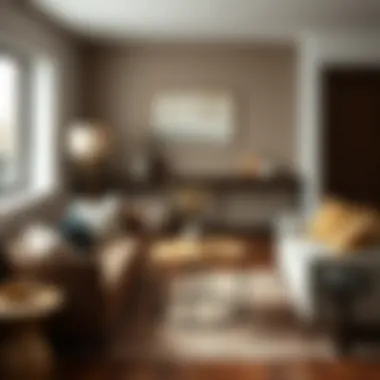
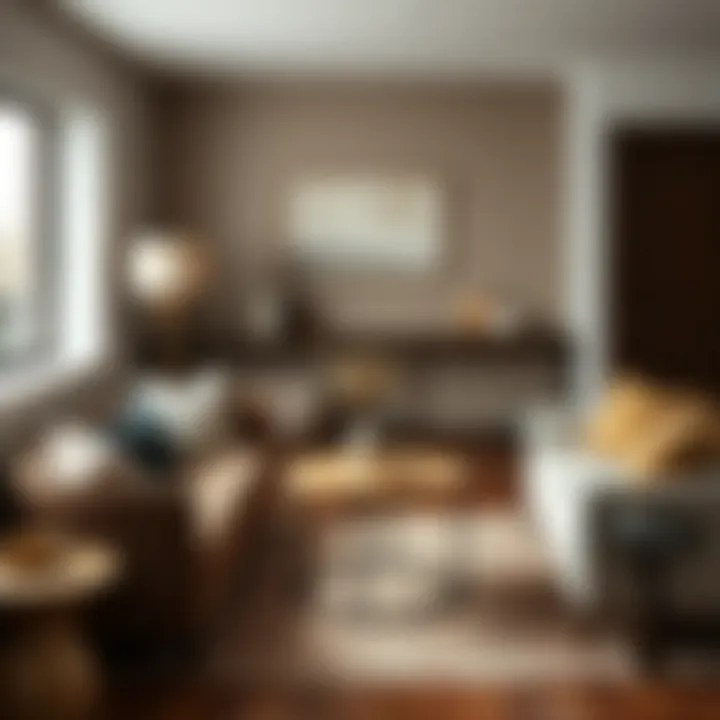
Finding the perfect round end table can significantly impact the overall aesthetic and functionality of your living space. The source you choose can influence not only the quality and design of the table but also how well it integrates into your existing decor. In this section, we'll delve into different avenues through which you can acquire these versatile pieces, including local furniture stores and online retailers.
Local Furniture Stores
Shopping locally has its perks. Visiting a physical store allows you to closely examine the craftsmanship of the tables and appreciate their textures and colors in person. Many local furniture shops offer a curated selection that reflects regional styles and trends. Additionally, local retailers often have knowledgeable staff who can provide personalized advice, helping you find that perfect piece.
- Benefits of Local Shopping:
- Hands-on Experience: It enables you to touch and feel the material quality.
- Immediate Availability: You can take your purchase home right away.
- Customization Options: Some local retailers offer customization services that allow you to tailor the design to your exact liking.
When you step into a local store, don’t hesitate to explore unique options that might not be promoted online. You’d be surprised how many gems can be unearthed when browsing the aisles.
Online Retailers
On the flip side, the digital marketplace brings a world of possibilities directly to your fingertips. Online retailers often boast vast inventories, allowing you to compare styles and prices with just a few clicks. Whether you’re looking for a modern chic round table or something more rustic, the online world has something for everyone.
- Advantages of Online Shopping:
- Diverse Selection: You can find countless styles, finishes, and sizes that might not exist in local stores.
- Convenience: Shop from the comfort of your home without any sales pressure.
- Customer Reviews: Online reviews can give you insight into the experience of previous buyers, guiding you toward quality products.
However, purchasing furniture online can carry its own set of risks. Always check the return policy and ensure the retailer has a reliable customer service team in case there are issues with your order.
Customization Options
When it comes to adding round living room end tables to your space, customization plays a role one can't overlook. Choosing a table that fits your personal style and your home’s aesthetic is paramount. Customization allows for a unique blend of function and personality in your living area. It’s like finding the missing puzzle piece that completes your room.
Bespoke Designs
Bespoke designs stand out because they are crafted specifically to meet the homeowner's needs and preferences. Think of it this way: a cookie-cutter table from a big-box store can make your space feel generic, while a made-to-order piece reflects your individual taste and enhances the overall ambiance.
By opting for bespoke designs, you gain freedom in terms of size, shape, material, and even finish. For instance, you might want a specific type of wood, like oak or walnut, intricately carved to reflect a particular style, be it minimalist or ornate.
Some considerations when pursuing bespoke designs include:
- Budget: Custom pieces can be pricier. Set a budget that allows for added detail without breaking the bank.
- Space Requirements: Measure your area well; custom tables can be tailored to fit awkward gaps or unique layouts.
- Functional Needs: Think about how you'll use the table—do you need extra storage? Look into designs that include drawers or shelves.
Bespoke designs are ideal for those who want to showcase their distinct flair while maintaining functionality.
DIY Projects
Creating your own round end table can be a rewarding experience that not only saves money, but also provides an outlet for creativity. DIY projects let you express yourself by mixing various materials and designs that resonate with your style. The steps to build a simple round end table may include:
- Choosing Materials: You might start with a wooden top, perhaps a tree stump for a rustic vibe, and metal legs for an industrial look.
- Gathering Tools: Common tools needed could be a drill, sandpaper, and even paint if you want to add color.
- Assembly: With basic skills, it's often quite simple to put it all together. Ensuring stability needs extra attention, so don’t skip quality checks.
Not only do DIY projects empower you to craft something unique, but they also allow for a personal story to be woven into the very fabric of your home. Plus, there’s pride in saying, "I made that!" It transforms your living room into a space filled with personal history and creativity.
"In the realm of interior design, it’s the personal touches that elevate a space from ordinary to extraordinary."
Combining bespoke designs and DIY projects can lead to a one-of-a-kind round end table that meets both aesthetic and practical demands. Whether you choose to commission a designer or roll up your sleeves for a weekend project, embracing customization ensures that your tables are far from just furniture—they become part of your home's story.
If you want more detailed guidance on having a custom piece made or venture into DIY projects, look into resources like Instructables or Pinterest for inspiration.
Trends Shaping Round End Tables
As we navigate the ever-evolving landscape of interior design, round living room end tables have taken center stage, reflecting broader trends that prioritize sustainability and technology integration. These shifts not only highlight aesthetic choices but also elevate the functionality of these pieces. Understanding these trends is vital for homeowners, designers, and decorators alike as they seek to curate spaces that blend style with practical needs.
Sustainable Materials
Sustainable materials are not just a trend; they’re becoming a norm that resonates with a growing commitment to environmental responsibility. Many designers are opting for materials that minimize ecological impact, such as reclaimed wood or bamboo. These options boast not only a unique visual appeal but also contribute positively to the environment.
By choosing sustainable materials, consumers can make a statement with their furnishings while supporting responsible sourcing practices. Consider a round end table crafted from reclaimed barn wood; it bears the story of its past while providing a unique aesthetic that no two pieces can replicate. This authenticity appeals to those who appreciate the narrative behind their furnishings.
There’s a boom in the use of composite materials too, making furniture lighter and more versatile. Often, these woods are sourced from fast-growing forests, ensuring that while beauty and function meet, so does sustainability. This is not just a fad but a meaningful shift towards eco-conscious living.
"Choosing sustainable materials is like planting a tree for the future; it shows care for our planet and the generations to come."
Tech-Integrated Designs
In our tech-savvy world, the fusion of technology with furniture design has opened doors to new functionalities in round end tables. Features like wireless charging pads and Bluetooth speakers are increasingly being integrated, allowing these tables to serve as multifunctional hubs.
A tech-integrated round end table can change the way we interact with our living spaces. Imagine a sleek glass surface with built-in touch controls that adjust lighting or play your favorite tunes. Homeowners can enjoy convenience while maintaining design integrity. This integration not only appeals to tech aficionados but also enhances the overall living experience, blending innovation with everyday needs.
Moreover, such tables cater to modern living, where spaces are often small and multifunctionality is key. A tech-friendly end table can provide a charging station, a place for drinks, and even storage without overwhelming the visual simplicity of a room. It's a smart solution for a clutter-free environment.
Whether it's through thoughtful material choices or embracing technological advancements, trends in round living room end tables reflect a bigger picture of how we can harmonize beauty and functionality in our homes. Understanding these aspects empowers homeowners and designers to make informed decisions as they curate inviting, contemporary living spaces.
Closure
As we wrap up this exploration into the world of round living room end tables, it's clear that these pieces hold more than just practical benefits. They play a vital role in shaping the feel and function of a space. It's not merely about placing a table beside a sofa; instead, it's about creating a cohesive environment that marries style and utility.
Recap of Key Points
In our detailed look at round end tables, several key takeaways emerge:
- Versatility: Round end tables seamlessly fit into various design schemes, from modern to eclectic.
- Functionality: They are not just decorative artifacts; they offer storage solutions and serve multipurpose roles.
- Material Choices: The variety of materials—from wood to glass—enables homeowners to select pieces that resonate with their personal style.
- Sizing and Placement: Proper sizing ensures that the table complements existing furniture, enhancing spatial harmony.
- Trends: Keeping an eye on contemporary trends, including sustainable materials and tech integrations, helps in making informed decisions.
Final Thoughts on Selection and Placement
When it comes to selecting and placing a round end table, consideration is paramount. Think about the function you wish for the table to serve. Is it simply for holding a drink, or do you envision it as a statement piece? Depending on its purpose, the selection should reflect both aesthetic preference and practical needs.
Likewise, placement can transform a living room's dynamics. Ideally, it should be easily accessible, yet not obstructive. When situated with intention, a well-placed round end table can enhance movement within a room and serve as a focal point that draws the eye.
Ultimately, the choice of a round end table should blend functionality with a sense of style that resonates within your home’s unique narrative. As you embark on this selection process, always remember: the right piece will not just fill space but elevate it.



